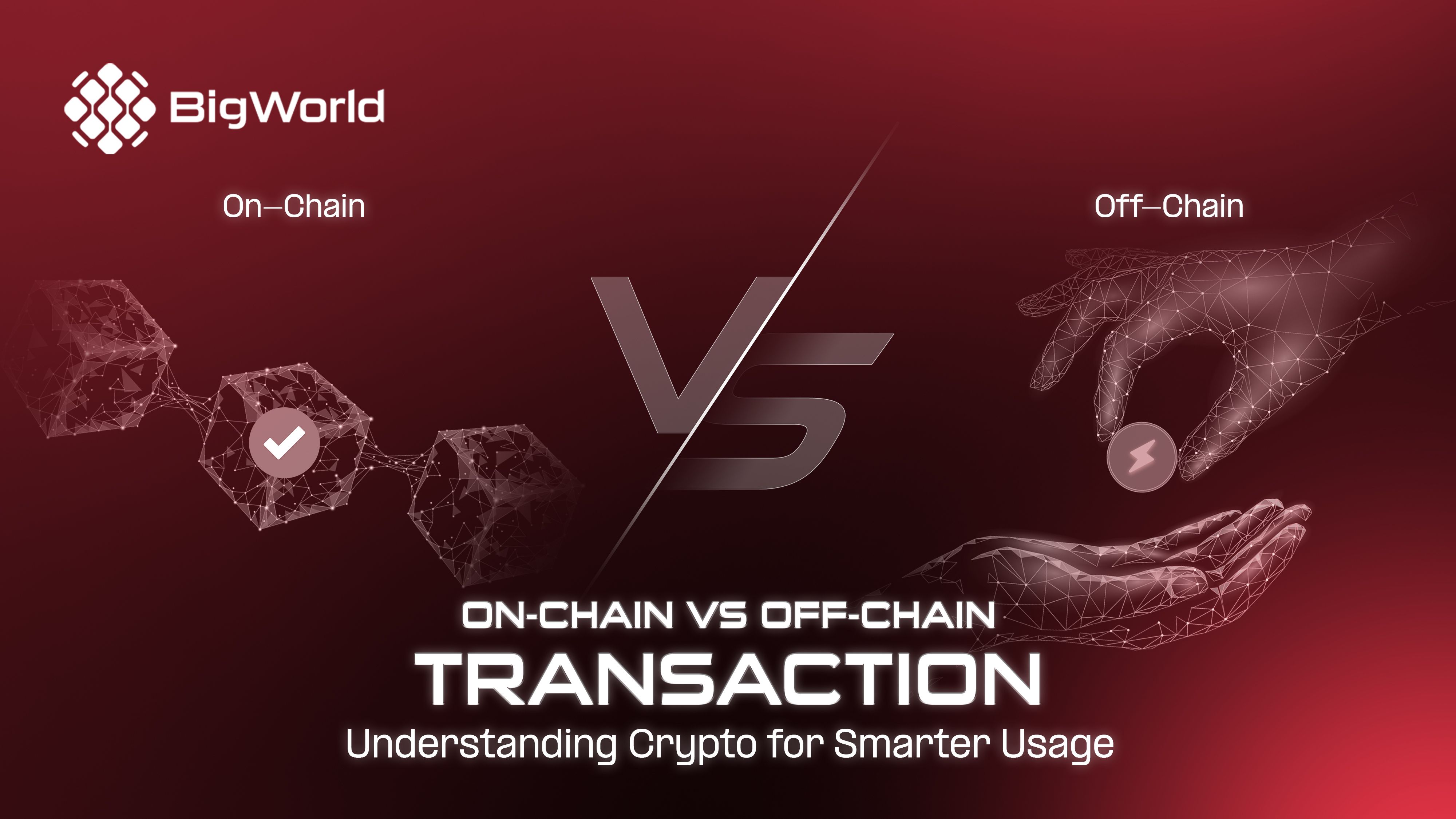On-Chain vs Off-Chain Transactions: Understanding Crypto for Smarter Usage

Many newcomers struggle to understand how crypto transactions actually work. What do “on-chain” and “off-chain” really mean, and why does it matter? Knowing the difference helps you save on fees, improve security, and choose the right strategy. BigWorld breaks down crypto clearly so you can navigate and invest with confidence.
1. What are On-Chain
On-chain transactions form the backbone of the crypto ecosystem, especially for those prioritizing transparency and long-term security in their activities. These transactions are ideal for high-value transfers because they are trustless, secure, and immutable—once written, they cannot be altered. This makes on‑chain activity the foundation for critical crypto functions like DeFi, NFTs, and large asset movements
The primary advantage of on-chain transactions lies in their trustless framework, removing the need for intermediaries and ensuring that all transaction data is permanently recorded on the blockchain. This makes them particularly valuable for high-value transactions, such as asset transfers and real estate deals, where security and certainty are essential. The blockchain’s inherent security features help reduce fraud risks, providing a reliable framework for critical financial activities.
However, on-chain transactions can face slower processing times due to network congestion and require higher transaction fees, especially during periods of high demand. These limitations can make them less practical for high-frequency transactions or micro-payments where speed and cost-efficiency are priorities.
For instance, sending Bitcoin from your wallet to another wallet, or swapping tokens on Uniswap, are on-chain transactions visible and verifiable on blockchain explorers.
2. What are Off-Chain
Off-chain transactions occur outside the main blockchain network and are not immediately recorded on the public ledger. Instead, they rely on alternative methods such as payment channels, Layer 2 solutions, or centralized exchanges to facilitate transfers without requiring on-chain confirmation at each step.
These transactions are well-suited for frequent trading, micro-payments, and situations where speed and lower fees are priorities. By bypassing the need for immediate network validation, off-chain transactions reduce congestion on the blockchain while enabling near-instant settlements.
Off-chain transactions excel in providing faster transaction speeds and lower or zero fees, making them well-suited for frequent trading, micro-payments, and situations where efficiency is key. By conducting transactions off the blockchain, they help reduce congestion on the main network while still allowing users to settle final transactions on-chain when needed.
Despite these benefits, off-chain transactions require trust in third-party platforms or intermediaries, and transactions are not immediately visible on the blockchain, reducing transparency. Additionally, users may face security risks depending on the practices of the platforms facilitating these transactions, which can introduce potential vulnerabilities compared to the trustless nature of on-chain systems.
Examples include, transferring USDT between two users within the same centralized exchange or using the Lightning Network for instant Bitcoin payments are off-chain transactions.
3. Comparision
Choosing the right transaction method is essential in crypto, whether you’re trading, investing, or exploring DeFi. Understanding how on-chain and off-chain transactions differ will help you navigate fees, speed, and security more effectively.

Keep this comparison in mind as you choose the right transaction method for your crypto goals. It will help you move through the crypto space with practical understanding and informed decision-making.
4. When Should You Use On-Chain vs Off-Chain?
Deciding between on-chain and off-chain transactions depends on your goals and needs in crypto. If you prioritize speed and want to minimize fees, off-chain transactions are a practical choice, especially for frequent trading or micro-payments. If you need transparency, strong security, and a permanent record on the blockchain for your transactions, on-chain transactions are the better option, particularly for DeFi activities or storing assets securely.
It’s also important to understand the risks when using off-chain transactions. Transactions on centralized exchanges depend on the platform's custody and security practices, while Layer 2 solutions offer off-chain speed with security anchored to the blockchain, providing a balanced approach for many crypto users.
5. The Future: Layer 2 and the Blend of On-Chain & Off-Chain
Layer 2 solutions are emerging as a powerful way to bridge the gap between on-chain security and off-chain efficiency. By processing transactions off the main blockchain and settling final states on-chain, Layer 2 technologies help reduce fees, increase transaction speeds, and alleviate network congestion while preserving decentralization and security.
Solutions like the Lightning Network for Bitcoin and zkRollups or Optimistic Rollups for Ethereum are evolving rapidly, enabling faster, cheaper transactions while maintaining the trustless nature of crypto. As these technologies continue to advance, they will play a critical role in scaling blockchain networks and improving the overall user experience for trading, payments, and DeFi activities.
BigWorld aims to contribute clear, practical crypto insights that support builders and investors in navigating Layer 2 and the future of blockchain scalability.

6. Last Words
Navigating crypto requires clarity, and understanding the differences between on-chain and off-chain transactions is part of building a strong foundation. These concepts will continue to influence how we invest, trade, and build in the crypto space as technology advances.
Here at BigWorld, we believe that by making these fundamentals clear and actionable, builders and investors can make better decisions and confidently contribute to the future of crypto.


.jpg&w=2048&q=75)